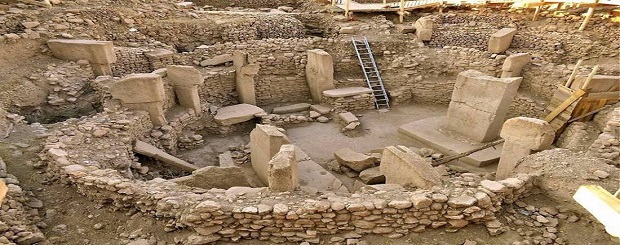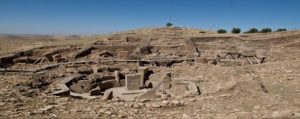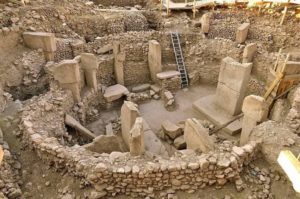
September 17, 2017 History – allinnet.info:
Today, many great scientists with world-renowned names believe that Armenia is the cradle of creation and civilization. Among other sources, the Bible and the oldest Sumerian legends say about it.
Following the work “The Cult of God Ar in Armenia”, a new book named “Armenia – the Cradle of Creation and Civilization” (in Armenian) was written, where questions about the cult of the god-creator Ar-Ara were covered again.
It was published in 2002 and republished in 2011. We propose you to read the summary of this book.
Armenia is one of the oldest centers of civilization. The centuries-old traces of material culture, mythological legends, geographical, and personal names testify to the fact that Armenians are the indigenous inhabitants of Armenian Highlands and have lived there since ancient times.
Greek historiography advanced its own version of the Armenian origins. Greek chroniclers (Herodotus, Xenophon, Strabo) consider Armenians to be of Thracian-Phrygian origin. The assumption was based on their common traditions, clothing, the types of weapons as well as the legend of Thessalian Argonaut Armenos.
In Armenian medieval historiography (5th-15th centuries, M. Khorenatsi, Agatangehos, P. Byuzand, Sebeos), it was widely believed that Armenians, the most ancient inhabitants of the Armenian Uplands, lived here after confusion of tongues as a result of the construction of the Tower of Babel.
Since the middle of the 20th century, scientists, especially linguists (V. Illich-Svitich, O. Shirokov, G. Klichkov, A. Dolgopolsky, V. Ivanov) put forward the view that the ancestors of peoples belonging to Indo-European languages are the Indo-Aryan tribes, which lived in Western Asia, more precisely, in the Armenian Highlands and the surrounding regions.
The theory of the whereabouts of the Indo-European homeland in the eastern parts of the Near East was elaborated by Tamaz V. Gamkrelidze and V. Ivanov in the cooperative work “Indo-European Language and Indo-Europeans”. This point of view has many supporters and is gradually entering scientific circulation.
In this work, an attempt was made to examine this version of the localization of the ancestral homeland of the Indo-Europeans in the Armenian Highlands and neighboring regions as well as the indigenism of Armenians in their homeland.
There is also a theory that Armenia is the center of creation and civilization according to the oldest mythological ideas and the Bible. In the work, all options that can confirm this version were considered.
Archeological, ethnographic, and linguistic aspects of the problem as well as the issue of ethnic movements were revealed, focusing on the Armenian ethnos, history, and the Armenian Highlands. In the work, the questions of the cult of the god-creator Ar-Ara (Armenian: Արարիչ, the Creator) were also discussed.
The oldest written sources (the Sumerian Enki and Ninmakh, the Akkadian Enûma Eliš (Enuma Elish), the Hurrian “About the Kingdom of Heaven”) testify that humans were created in the country of Abzu, otherswise, in the country of Mother Earth, under the auspices of the wisdom of god Ea/Aya/Haya/Enki.
This country is also known under other names – Kur, Irigal, Arali. From the above and other written sources, it is obvious that the geographical location of Abzu corresponds to the area where the sources of the Euphrates and Tigris rivers are located, namely, in the Armenian Uplands. The Bible also shows that the human race was created in the region of the sources of the rivers Euphrates, Tigris, Gehon (Araks), and Pison (supposedly, Kura).
The humans created on earth under the patronage of the god Aya considered themselves hays, which means “inhabitant of the earth” or “earthly creature”. According to Hurri-Armenian mythology (“Poem of the Kingdom of Heaven”, “Birth of Vahagn”) originated on the territory of the Armenian Highlands, humans were created in the country of the god Aya by the combination of the mother god of the land of Aya and the heavenly creator of Sun Ar (Armenian: Արև, Arev, hence Ar/Ara).
And the inhabitant created in the Armenian Highlands, hay, combined the cult of the goddess of the Mother Earth Aya with the cult of the father, creator god Ar. The humans also considered themselves the children of god Ar.
The land where the hay-Armenians were created was named Ararat, (Armenian: արարել, ararel, English: create, hence Arar-at, place of creation), Hark, Hayk.
During a certain historical period, the Sun, the biggest and brightest light that gave people warmth and life, was considered a manifestation of the power of the creator, so hay-Armenians worshiped him as the god Ar-Ara, the Sun-god.
Thus, it can be said that by their names, the hay-Armen, the inhabitants of the Armenian Highlands, are a kind of bridge in the Universe linking the Mother Earth (goddess Aya) to the Cosmos (god-creator Ar-Ara).
At the beginning of the 3rd millennium BC, Semitic tribes, Akkadians, Babylonians, and Assyrians moved from Arabian Peninsula to northern Mesopotamia (south of the Armenian Highlands).
In the process of communicating with the inhabitants of the Armenian Highlands, where the oldest legends about the origin of the hay-Armenians were preserved, the Semitic tribes learned that they were the inhabitants of the country of the god Aya and the offsprings of the god of creation Ar. And the Akkadians also called the inhabitants of the Armenian Highlands the sons of the god Ar, that is, armand, arme (n), and their country – Armani, Arme.
Subsequently, in the 2nd-1st millennium BC, the Greeks and Persians named the inhabitants of the Armenian Highlands Armenians and the country Armenia. The work emphasizes the important role and significance of the cult of the god Ar in the creation of the spiritual and material culture of the Armenian tribes (also of other Indo-Aryan tribes). Much attention was paid to the god Ar, the god of the Sun, and to the question that Armenia is the oldest country of the cult of sun and light.
Studies show that the name, cult, and ideology of the god Ar can contribute to the study of many issues of the ancient history of Armenians (also of other Indo-European peoples), including the names of many state entities such as Aratta, Armani, Arme-Urme, Ararat-Urartu, later deities, such as Aramazd, Ahuramazda, Ares, Aras, Ram, Mars, which inherited the characteristics of the god Ar.
Questions regarding personal and geographical names are also being examined. On the Armenian plateau in the 4th-3rd millennium BC, there was a rapid development of the means of production, which in turn led to an increase in the number of people and settlements.
This fact played a big role in ethnic migrations. As a result of this process, a part of the Armenian tribes, the ancestors of the Indo-European Aryan tribes, moved to Iran, India, Greece, and other European regions (3rd-1st millennium BC), preserving the spiritual connection and remote memories of the country of their ancestors and the sacred mountain Ararat (the name of the ancient Slavic and Russian hero Svyatogor also confirms this).
They also adopted the names of their ancestors, hay, ari (Armen, armand), which contained the characteristic features of the ethnos – high, noble (hay), brave and strong (Armenian: Արի, ari, brave).
Time and space weakened the memories of their homeland, but spiritual and material values like myths, legends, traditions, as well as traces of the worship of god Ar-Ara return people to the land of light and sun, to Armenia.
The sections Armenia-Sumer, Armenia-India, Armenia-Iran, Armenia-Greece, Armenia-Britain, Armenia-Germany, Armenia-Iberian Peninsula (Spain, Baskonia) and Slavic tribes (Russians) as well as spiritual and cultural ties between them are represented in the work.
The fact that the Armenian language, in contrast to other Indo-European languages, has all the phonetic sounds specific to Indo-European languages is also interesting. Anthropological studies also show that the Armenian Highlands are in a range which an Austrian scientist von Luschan called “the birthplace of the Armenoid type.”
Thus, research gives us the opportunity to assume that the distant ancestors of the Indo-European peoples, the Aryan tribes in the Armenian Highlands, formed a tribal community with a single homeland. They worshiped the same gods (Ar-Ara, Aramazd, Vahagn, Mihr-Mitra, Anahit) and created a common culture, the heritage of which has survived to our days.
Anjela Teryan, “Ancient Written Sources of European People About Their Homeland, Armenia, and Armenians”, Yerevan, 2016 Download the full version of the book in Russian


allinnet.info/history/the-most-ancient-history-of-armenia/
